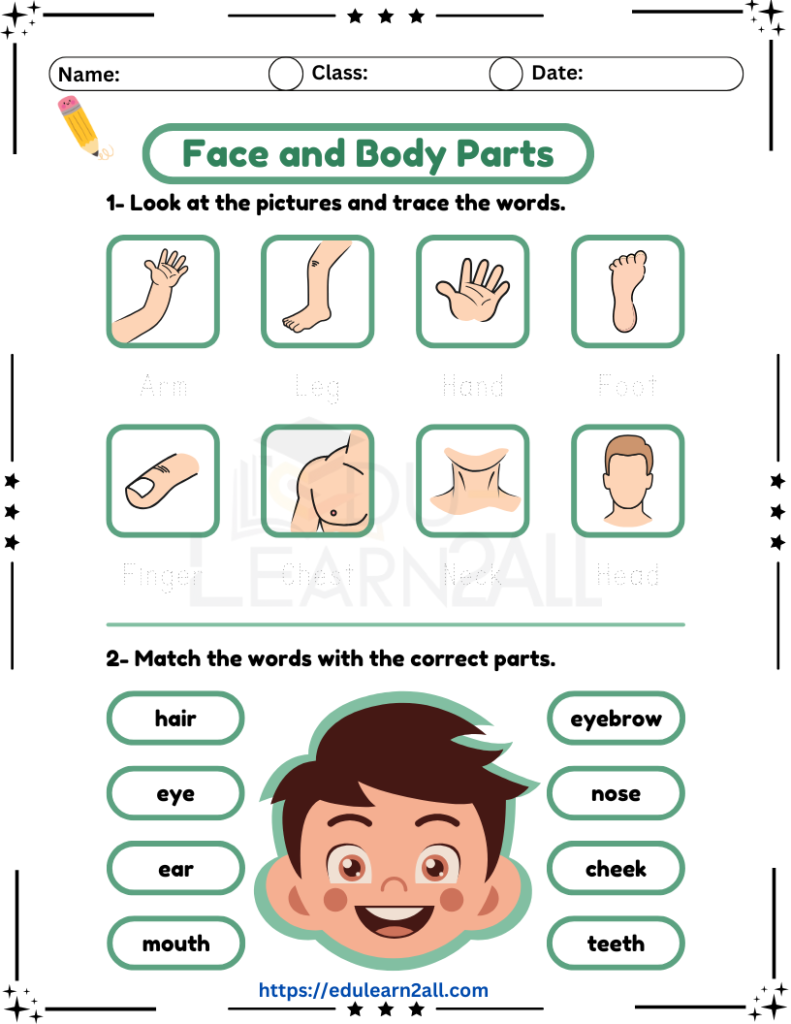Introduction
Parts of a Body Worksheet Understanding the human body is a fundamental aspect of education, especially for students studying biology, health sciences, or even art. A “Parts of a Body Worksheet” is an excellent tool to help learners of all ages identify, label, and comprehend the various components of the human body. This article provides a detailed guide to creating and using such worksheets, along with tips for maximizing their educational value.
Why Use a Parts of a Body Worksheet?
Worksheets are interactive and engaging tools that make learning fun and effective. Here’s why they are particularly useful for teaching anatomy:

- Visual Learning: Worksheets often include diagrams, which help visual learners grasp complex concepts.
- Hands-On Practice: Labeling and coloring activities reinforce memory retention.
- Self-Paced Learning: Students can work at their own pace, ensuring they fully understand each part before moving on.
- Assessment Tool: Teachers can use completed worksheets to evaluate students’ understanding of the topic.

Key Components of a Parts of a Body Worksheet
A well-designed worksheet should include the following elements:

1. Clear and Detailed Diagrams
- Provide labeled and unlabeled diagrams of the human body.
- Include both external (e.g., head, arms, legs) and internal (e.g., heart, lungs, brain) body parts.
- Use high-quality images to ensure clarity.

2. Labeling Activities Parts of a Body Worksheet
- Ask students to label different parts of the body on a diagram.
- Include a word bank for younger learners or beginners.

3. Matching Exercises
- Match body parts with their functions (e.g., “heart” with “pumps blood”).
- Match body parts with their locations (e.g., “skull” with “head”).

4. Coloring Sections
- Allow students to color different parts of the body to make learning more interactive.
- Use color-coding to group related parts (e.g., all bones in one color, muscles in another).

5. Fun Facts and Trivia
- Include interesting facts about the human body to spark curiosity.
- Example: “Did you know the human heart beats about 100,000 times a day?”

6. Quiz or Review Section
- Add a short quiz at the end to test students’ knowledge.
- Include multiple-choice questions, fill-in-the-blanks, or true/false statements.
How to Create a Parts of a Body Worksheet
Creating an effective worksheet requires careful planning. Follow these steps:
Step 1: Define the Learning Objectives
- Determine what students should learn from the worksheet (e.g., identifying major organs, understanding their functions).
Step 2: Choose the Right Format
- Decide whether the worksheet will focus on external anatomy, internal organs, or both.
- Select age-appropriate content and language.
Step 3: Design the Layout
- Use a clean and organized layout to avoid overwhelming students.
- Include headings, subheadings, and clear instructions.
Step 4: Add Engaging Content
- Incorporate diagrams, activities, and fun facts to keep students interested.
- Use bold fonts or colors to highlight important information.
Step 5: Review and Test
- Proofread the worksheet for errors.
- Test it with a small group of students to ensure it’s effective and easy to understand.

Sample Parts of a Body Worksheet
Here’s an example of what a worksheet might look like:

Worksheet Title: Exploring the Human Body
Section 1: Label the Diagram
- Diagram: A blank outline of the human body.
- Instructions: Label the following parts: head, shoulders, knees, toes, heart, lungs, stomach, and brain.

Section 2: Matching Activity
- Match the body part to its function:
- Heart – Pumps blood
- Lungs – Helps you breathe
- Brain – Controls thoughts and movements
- Stomach – Digests food

Section 3: Coloring Activity
- Color the bones in the skeleton diagram red and the muscles blue.

Section 4: Fun Facts
- Did you know? The smallest bone in the human body is in your ear!
Section 5: Quiz
-
- What is the largest organ in the human body?
a) Heart
b) Skin
c) Liver
- True or False: The brain is part of the nervous system.
- What is the largest organ in the human body?
Tips for Using the Worksheet Effectively
- Pair with Hands-On Activities: Use models or real-life examples to complement the worksheet.
- Encourage Group Work: Let students work in pairs or small groups to discuss and learn together.
- Provide Feedback: Review completed worksheets and offer constructive feedback.
- Adapt for Different Ages: Simplify the content for younger learners or add more detail for advanced students.
The five Senses

Benefits of Learning About the Human Body
Understanding the parts of the body is not just academic—it has real-world applications:
- Health Awareness: Knowing how the body works encourages healthy habits.
- Career Preparation: It lays the foundation for careers in medicine, fitness, and science.
- Curiosity and Exploration: It sparks interest in the natural world and how living organisms function.

Conclusion
A “Parts of a Body Worksheet” is a versatile and effective educational tool that can make learning anatomy engaging and enjoyable. By incorporating clear diagrams, interactive activities, and fun facts, you can create a resource that caters to different learning styles and age groups. Whether you’re a teacher, parent, or student, these worksheets are a great way to explore the fascinating world of the human body.
